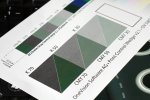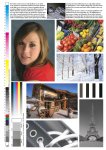Hi everyone, i hope im asking this question in the right place and if not i would be thankful if the mods place my thread in a correct category.
Im doing a project on ink saving which involves determining the high point of ink saving a company should use without risking loss of quality (there are alaso other goals and plans, but i dont wanna be too long). As this is a personal project so my finances are limited and im working with printing facilities who offer me their work in exchange for my results.
This is how i planned to do my research.
- I prepared a test printing form with test images (skin tones, grays, saturated tones, low key and high key images and so on.) and wedges which includes a OneVision software GCR wedge with 70cmy/70k fields and a 50/50 + a 30/30 field. I also used fogras ECI/bvdm gray control strip in the L variant.
- I made the pdf's and optimized them in OneVision Asura software with a workflow used by a local printing facility. I wrote down all the options they include in their workflow and i only changed the level of GCR or ink saving optimization. I used 4 levels, from lowest to highest.
- I then made the plates, no problems there.
- The printing process.
This is where the PROBLEMS BEGIN, on files with NO or little optimization the printer told me he could not avoid the GREEN overcast on gray balance fields, without comprimising the color quality of the test pictures below. He told me he tried fixing the gray balance but if he cought the right balance with little to no overcast on CMY test fields the test images would look horrible, so he kept the way images look and left a green overcast on gray balance fields.
Below is a picture where the problem is at its worst, you can see the green overcast on the CMY fields. This is the print from the plates with LOWEST amount of GCR. In the prints with higher amount of GCR there is less of a green overcast, somewhere even none.

(click on image to enlarge)
So with my knowledge i have come to this conclusions:
- I wasnt in the print shop while the printing was in process, so lack of effort and a simple quality print would solve this problem. (printing was pro-bono, if that makes any difference)
- A problem in pre-press, although everything went according to standard, nothing i would notice went wrong.
- Logical explanation is, the amount of C and Y ink is excessive so a green overcast is formed, again i checked the plates and files from the RIP and everything is in order, so not a pre-press issue.
I would be very happy of every reply, i can provide more pictures of the prints or even microscopic pictures of the plates and prints i made, trying to solve the problem. Doing the whole printing process again would be my first step in fixing this issue, what do you think?
p.s.: Prints comply with the standardized ISO coated paper LAB and density values. Quality still isnt satisfactory.
Im doing a project on ink saving which involves determining the high point of ink saving a company should use without risking loss of quality (there are alaso other goals and plans, but i dont wanna be too long). As this is a personal project so my finances are limited and im working with printing facilities who offer me their work in exchange for my results.
This is how i planned to do my research.
- I prepared a test printing form with test images (skin tones, grays, saturated tones, low key and high key images and so on.) and wedges which includes a OneVision software GCR wedge with 70cmy/70k fields and a 50/50 + a 30/30 field. I also used fogras ECI/bvdm gray control strip in the L variant.
- I made the pdf's and optimized them in OneVision Asura software with a workflow used by a local printing facility. I wrote down all the options they include in their workflow and i only changed the level of GCR or ink saving optimization. I used 4 levels, from lowest to highest.
- I then made the plates, no problems there.
- The printing process.
This is where the PROBLEMS BEGIN, on files with NO or little optimization the printer told me he could not avoid the GREEN overcast on gray balance fields, without comprimising the color quality of the test pictures below. He told me he tried fixing the gray balance but if he cought the right balance with little to no overcast on CMY test fields the test images would look horrible, so he kept the way images look and left a green overcast on gray balance fields.
Below is a picture where the problem is at its worst, you can see the green overcast on the CMY fields. This is the print from the plates with LOWEST amount of GCR. In the prints with higher amount of GCR there is less of a green overcast, somewhere even none.

(click on image to enlarge)
So with my knowledge i have come to this conclusions:
- I wasnt in the print shop while the printing was in process, so lack of effort and a simple quality print would solve this problem. (printing was pro-bono, if that makes any difference)
- A problem in pre-press, although everything went according to standard, nothing i would notice went wrong.
- Logical explanation is, the amount of C and Y ink is excessive so a green overcast is formed, again i checked the plates and files from the RIP and everything is in order, so not a pre-press issue.
I would be very happy of every reply, i can provide more pictures of the prints or even microscopic pictures of the plates and prints i made, trying to solve the problem. Doing the whole printing process again would be my first step in fixing this issue, what do you think?
p.s.: Prints comply with the standardized ISO coated paper LAB and density values. Quality still isnt satisfactory.
Last edited:















